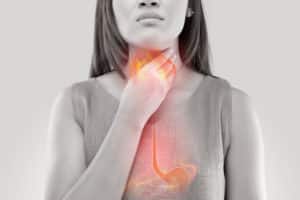
What is laryngopharyngeal reflux (LPR)?
When people eat or drink, the food or beverage travels to the stomach through a tube that runs from the throat to the stomach, called the esophagus. The esophagus has two muscular rings called sphincters at either end, which can open and close to allow substances to enter the stomach. Once the food or drink is in the stomach, the sphincter acts as a barrier to keep it inside the stomach and out of the throat.
Gastroesophageal Reflux
In some people, the sphincter does not function properly and consumed food or drinks, as well as stomach acids, are able to enter the esophagus again. This is called gastroesophageal reflux (GER) or gastroesophageal reflux disease (GERD).
Laryngopharyngeal Reflux
When the condition is severe enough that the stomach acid goes all the way through the esophagus, past the top sphincter, and into the throat, it is known as laryngopharyngeal reflux (LPR).
What are LPR symptoms?
LPR reflux can cause any of the following symptoms:
- Bitter taste in the back of the throat
- Sensation of a lump stuck in throat
- Burning sensation in the throat
- Difficulty breathing

How is laryngopharyngeal reflux diagnosed?
The best way to diagnose a throat condition is to visit an ear, nose, and throat specialist, such as New York ENT, to undergo an evaluation. This evaluation may include a physical examination, evaluation of symptoms and medical history, and if needed, an endoscopy procedure.
What is an Endoscopy?
During an endoscopy, doctors use a small cord to view the inside of the esophagus and asses for damage due to LPR.
How is laryngopharyngeal reflux treated?
LPR is an extension of GERD, so often the treatment will be similar to treating GERD. Some doctors will recommend a laryngopharyngeal reflux diet, which may consist of eating smaller portions of food and drink more frequently throughout the day.
In addition to using an LPR diet, laryngopharyngeal reflux treatment may include sitting upright or sleeping at a slightly vertical angle, especially right after sleeping. When these interventions are unsuccessful, an ear, nose, and throat doctor may recommend surgery. Treatment options will vary depending on each patient and should be discussed with your New York ENT doctor.
Schedule a Consultation
If you are suffering from LPR, the first step towards feeling better is to schedule an evaluation with an experienced ear, nose and throat doctor. Board-certified physicians with New York ENT have extensive experience diagnosing and treating a wide variety of neck and throat conditions. Fill out the form on this page or call our office at 212-873-6036 to schedule an appointment today.



